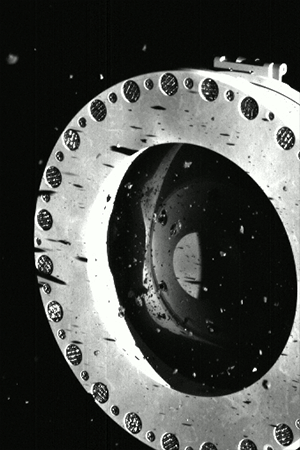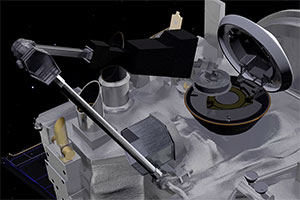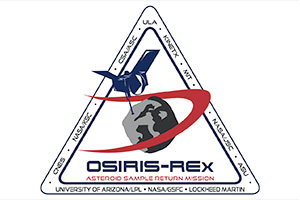October 23, 2020 — NASA's first attempt at collecting a sample from the surface of an asteroid appears to have been so successful that its probe is overflowing with flakes of soil and stone.
Three days after the OSIRIS-REx robotic spacecraft descended to the small asteroid Bennu, extended its robotic arm and "tagged" the rocky body to gather up a sample, the mission's lead scientist said the Touch-And-Go (TAG) maneuver may have been "almost too successful."
"This is the mission that keeps on surprising us and certainly that was the case [here]," Dante Lauretta, OSIRIS-REx principal investigator at the University of Arizona in Tucson, said in a call with reporters on Friday (Oct. 23). "We do have abundant visual evidence that there is a substantial mass of Bennu regolith."
On Thursday, the spacecraft took images of its sample collector head and, on review, Lauretta and his OSIRIS-REx (or Origins-Spectral Interpretation-Resource Identification-Security-Regolith Explorer) team saw that it appeared to be full of asteroid particles. They also saw that some of those particles appeared to be slowly escaping from the collector, called the Touch-And-Go Sample Acquisition Mechanism (TAGSAM) head.
Those flakes of material were passing through small gaps where a mylar flap — the collector's "lid" — is slightly wedged open by larger rocks.
"In the longer exposure images, we can see there are, in fact, large particles — some of them almost as big as 3 centimeters in visible long dimension and 2 centimeters in short dimension [1.2 by 0.8 inches], right at the size that can fit through that orifice into the TAGSAM collection area — and they appear to be jammed in there," Lauretta said. "They appear to be keeping the TAGSAM flap open."
The images showed that any movement to the spacecraft and the collector head could lead to further sample loss.
"I was immediately concerned because this is a loss of sample and sample mass," said Lauretta. "We've done a lot of analysis on the size distribution of these particles ... and in any given image we see between 5 and 10 grams [0.2 to 0.6 oz] estimated mass floating around the TAGSAM head."
NASA's requirement for the OSIRIS-REx mission was to collect at least 2 ounces (60 grams) of Bennu's surface material to bring back to Earth. The collector head had the capability of holding up to 4.4 pounds (2 kilograms). Based on the images, Lauretta estimated that there are least 14 oz (400 grams) of material in the head.
To retain as much of the collected sample as possible, Lauretta, in consultation with the other mission team members and Thomas Zurbuchen, NASA's associate administrator for science, decided to forego taking a mass measurement that had been planned for Saturday and canceled a braking burn that had been scheduled for Friday to minimize any acceleration to the spacecraft.
"I directed the team to put as minimal activity on the spacecraft as necessary and start focusing on the early stow of the sample to preserve and prevent any future mass loss," said Lauretta. "We're hopeful that we can expedite that and begin next week."
The collector head will be stowed in the probe's sample return capsule, the part of the OSIRIS-REx spacecraft that will land on Earth. The process includes severing the head from the robotic arm then closing the capsule for the journey home. The move could result in a sample loss similar to what was seen during the maneuvers to take the images of the collector head, according to Lauretta.
"Once the TAGSAM head is safely stowed in the return capsule and the return capsule is closed, it is protected and there will be no more mass loss. Material may still leak out of the head, but it will just be inside the science canister and we're prepared to clean all that up once we're back on Earth and disassembling the hardware at NASA's Johnson Space Center," he said.
The OSIRIS-REx spacecraft is scheduled to depart Bennu in March 2021 and will follow a two-and-a-half-year trajectory back to Earth. There, the sample capsule will separate, enter the atmosphere and land at the Utah Test and Training Range on Sept. 24, 2023. |
|

Taken on Oct. 22, 2020, this series of three images shows that the Touch-and-Go Sample Acquisition Mechanism (TAGSAM) head on NASA’s OSIRIS-REx spacecraft is full of rocks and dust collected from asteroid Bennu. Some of the particles are slowly escaping the collector head. (NASA/Goddard/University of Arizona)

Rendering of the OSIRIS-REx Touch-And-Go Sample Acquisition Mechanism (TAGSAM) head being stowed inside the spacecraft's sample return capsule for the journey back to Earth. (NASA)

OSIRIS-REx Asteroid Sample Return Mission logo. (NASA) |
